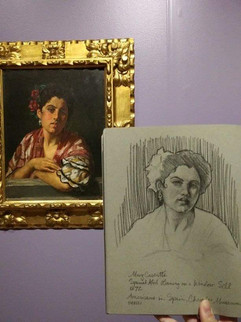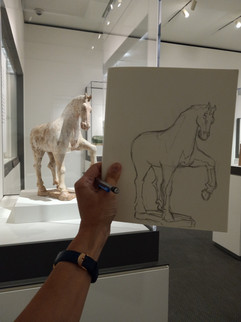Museums are Libraries for Artists
By Rowena F. Finn
I can remember the exact stages of my local art museum, the Chrysler, becoming an integral part of my life. It started with mandatory school field trips when I was little. The daunting stone building felt cold, impersonal, and not particularly inspiring. Visiting decades later as a young adult and aspiring artist, I was instantly smitten by the new warm, welcoming atmosphere, and especially by the incredible permanent collection and exhibitions. The more I visited, the more I noticed people drawing in their sketchbooks and realized maybe I could do that, too. But I thought you needed special permission because I only ever saw one or two people with sketchbooks. I finally decided to give it a go several years ago, and I was so nervous whenever someone walked by to peek at my work. These days, I’m so comfortable drawing there it feels like a second home. I especially love it when visitors look at what I’m doing and strike up a conversation.
Over the years I’ve come to think of art museums as visual libraries for artists. Artists can visit as often as we want, stay for hours, and study as much as necessary. There’s something deeply human about forging a connection to artists who’ve done this very same thing for hundreds of years. Walking through galleries and spending a minute or two in front of each work of art is one thing, but taking the time to draw is such an intimate way to understand a work of art and the artist’s thought process. And although most of us work in the solitary confinement of our studios, drawing in a museum can be just enough social interaction to leave us feeling rejuvenated before getting back to work.
Like libraries, there’s something for everyone in every museum. If you draw slowly like I do, you can work as long as you like and come back as often as you need. If you’re more of an urban sketcher, every space provides ample people watching for quick drawing. Did you know you can ask to view works that are not currently on display? Once a year my local watercolor group gets up close and personal with artworks that are often not even framed. It’s an incredible experience to scrutinize brushstrokes so closely that your nose is almost touching the painting.
Sometimes museums can feel aloof, but the truth is that most of them love it when artists of all levels draw in the galleries. I collaborate regularly with the Chrysler Museum, teaching drawing workshops that encourage people to come and draw as often as possible. The more of us that take advantage of drawing on site, the more we encourage aspiring artists of all ages to do the same.
Keep in mind there are a few basic rules about drawing in a museum, and definitely check with them first to make your experience go as smoothly as possible.
Bring dry media only: pencils, colored pencils, or pens that won’t leak.
A kneaded eraser is great because it won’t leave any eraser dust behind.
If you bring a large satchel or backpack, they may request you to carry it in a specific fashion to avoid accidentally knocking into artwork.
You still can’t get too close to the artwork - that rightly makes gallery hosts nervous.
Sometimes the lighting isn’t great so you might want to bring a book light to clip onto your sketchbook.
Some museums are happy to arrange for single artists or groups to come and paint in oil, acrylic, or watercolor, but you must contact them for more information.
Unfortunately, not all museums are free, but if you are able, I highly recommend grabbing your sketching gear and heading over to any one of these museums which are completely free to the public:
The Chrysler Museum of Art, Norfolk, VA
Virginia Museum of Fine Arts, Richmond, VA
The National Gallery of Art, Washington, DC
Hirshhorn Museum and Sculpture Garden, Washington, DC
The Freer Gallery of Art, Washington, DC
National Museum of African Art, Washington, DC
The National Portrait Gallery, Washington, DC
Crystal Bridges Museum of American Art, Bentonville, AK
Cleveland Museum of Art, Cleveland, OH
Cincinnati Art Museum, Cincinnati, OH
Bronx Museum of the Arts, New York City, NY
The Menil Collection, Houston, TX
Baltimore Museum of Art, Baltimore, MD
The Walters Art Museum, Baltimore MD
Minneapolis Institute of Art, Minneapolis, MN
Birmingham Museum of Art, Birmingham, AL
Institute of Contemporary Art, Miami, FL
The Nelson-Atkins Museum of Art, Kansas City, MO
Mississippi Museum of Art, Jackson MS
The Georgia Museum of Art, Athens, GA
Utah Museum of Contemporary Art, Salt Lake City, UT
Museum of Contemporary Art, Los Angeles, CA
This is by no means a comprehensive list, so please comment below to recommend additional free museums. Some of the museums listed above charge for special exhibitions. Other museums offer free admission days so you might want to sign up to get email notifications. Also, see below for some of my recent museum visit sketches.























































Comments